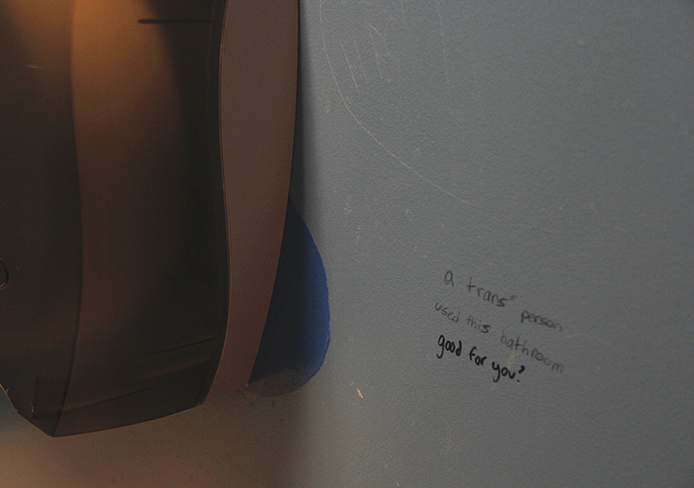
Bathroom graffiti in the Journalism Building. A Lantern columnist said bathroom graffiti at Ohio State is disrespectful to people and property. Credit: Ritika Shah / Asst. photo editor
Self-expression has intrinsic value because it allows for creativity and individuality, however, not all expressiveness is equal. Forms that are crass, hurtful and altogether loathsome, like some restroom graffiti, are not worthy of one’s expressive potential.
At Ohio State, certain restroom stalls are rampant with this kind of vandalism. In the worst cases, a hodgepodge of sexually inappropriate and xenophobic writings and drawings cover the stall. Just as wallpaper decorates, these scribbles degrade.
Some might argue restroom graffiti is one of the most pure forms of expression because it is unfiltered. But even if a piece of graffiti is relatively mild in tone and substance, in effect, it serves the same function as harsh graffiti — the defacement of a restroom.
Although this graffiti might be done in an expressive or creative manner, it is still inappropriate because it disrespects both people and property.
While OSU acknowledges that the defacement of a restroom stall is unbecoming for its students, if it does not include the destruction of property, is not necessarily against the OSU’s Code of Student Conduct. Often an act of defacement falls under the authority of the Office of Student Life’s Bias Assessment and Response Team.
Even if the wrongdoer is not caught, restroom graffiti does not go without consequences. If during its daily inspection, a restroom stall is found to have particularly derogatory graffiti, efforts will be made to remove it.
“Any graffiti of an offensive nature is removed immediately upon discovery,” said Lindsay Komlanc, spokeswoman for OSU Administration and Planning in an email Jan. 21. “Every effort is made to respond to cases of graffiti in an efficient manner.”
Restroom graffiti is nothing if not disruptive. By its very presence, it forces others to observe it and work to remove it. Offensive graffiti is contrary to the essence of this university, which is why OSU work crews put in considerable effort to ensure that facilities are “clean, safe, professional and conducive to supporting teaching, learning and research,” Komlanc said.
If people understand public space is not their personal property and that self-expression must be balanced with respect for others, restroom graffiti could decrease. However, in the meantime, OSU will continue to have to clean up the mess made by some of its most immature students.


